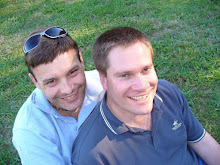From Iguazu Falls, we flew to Buenos Aires, our final stop in South America. Our flight proved to be fortuitously timed, landing minutes after midnight on 25 November. We heard later that just hours after landing, the airline we'd flown, Transportes Aéreos del Mercosur (part of the LAN network), went on strike. Phew! Buenos Aires, or BA as the locals call it, is a fascinating place. It’s unlike any other city we’ve seen in South America. It looks and feels like a classic European city with architecture reminiscent of Paris and Prague.
We spent our first full day in town wandering the streets and soaking up the experience. This included a stroll down Florida, a pedestrianized street extending all the way into Plaza de Mayo, the historic hub of Buenos Aires. Imagine if you can a narrow boulevard lined with block after block of European-style colonial buildings, punctuated at intervals by wrought iron balcony balustrades, curved canvas awnings and eye-catching carved stone window casings and doorway pillars.
Plaza de Mayo and its surrounding streets were filled with yet more colonial colour and character. The plaza itself is home to an array of impressive Government buildings, including the Casa Rosada, a pink-hued stone building that houses the Argentine President's office. Nearby the cupola-crowned Congresso Nacional, otherwise known as the national parliament, towers over the equally expansive, tree-lined Plaza del Congreso.
However, these dramatic public buildings weren’t the only thing that gave the Microcentro district such memorable charm. For example, given its role as the nation’s political heart, it was no surprise when we stumbled upon a colourful protest march heading from Plaza de Mayo to Plaza de Congreso. If Google’s translator is correct, this rowdy, colourful crowd was calling for more liberal abortion rights. Equally, large and fragrant Jacaranda trees in full bloom added to the area's colourful tapestry.
While on our way into town, we took a brief detour as far as Avenida 9 de Julio to view El Obelisco. This 67.5-metre-high white obelisk is considered one of the city's iconic landmarks. It was erected in Plaza de la República to mark the fourth centenary of the city's founding in 1936. I was thrilled to finally see it with my own eyes. Although I must admit, the aerial images you see online are far more dramatic than a ground-level view.
As expected, there was plenty of street art to admire wherever we went. Some of its rather sombre including an equestrian statue of Julio Argentino Roca, who served as the nation's president from 1880 to 1886. During his tenure, he was ultimately responsible for the extermination of more than 20,000 Mapuche Indians. He and his horse stand astride an austere plinth in the middle of an intersection, a block or so diagonally south of Plaza de Mayo.
On a lighter note, I found time to get up close and personal with a couple of Tango Dancers we encountered on Defensa Street in San Telmo, a wonderfully old and atmospheric residential district. San Telmo reminded me of the side streets I've wandered in Barcelona, Paris and Rome. Streets filled with iconic old buildings, ornate stone churches, locals shopping in cluttered, nondescript stores staffed by friendly staff everyone knows.
Between 1813 and 1818, San Martín led crucial moments in the fight for independence, defeating Spanish troops at the Battle of San Lorenzo, reorganising the Army of the North, becoming Governor of Cuyo, and creating the Army of the Andes, which he led across the mountains into Chile to liberate the neighbouring country from Spanish rule, before moving north to liberate Peru in 1820.
We spent the following day walking through the Retiro historical district, located to the north of our hotel, before heading towards the harbour. Highlights along the way included an impressive monument to General José de San Martín, renowned as the liberator of Argentina. This impressive edifice was created in 1862 by French sculptor Louis Joseph Daumas. It was the first equestrian statue in the city (and I attest to the fact that they've installed plenty more equine edifices since then).
Between 1813 and 1818, San Martín led crucial moments in the fight for independence, defeating Spanish troops at the Battle of San Lorenzo, reorganising the Army of the North, becoming Governor of Cuyo, and creating the Army of the Andes, which he led across the mountains into Chile to liberate the neighbouring country from Spanish rule, before moving north to liberate Peru in 1820.
Apparently, you can book yourself a lesson or two. We certainly saw plenty of brochures to this effect on offer in our hotel room and in the lobby downstairs. Although it’d be fair to say we weren’t keen to embarrass ourselves after seeing so many incredibly slick street performances.
Instead, to cap off our last full night on the continent, we shouted ourselves tickets to the best Tango show in town. It was held in a small, intimate venue inside the Faena Hotel, called Rojo Tango. Much to our delight we were seated at a small table, just metres from the stage (you can get a feel for the venue from the image published on its website below).
Instead, to cap off our last full night on the continent, we shouted ourselves tickets to the best Tango show in town. It was held in a small, intimate venue inside the Faena Hotel, called Rojo Tango. Much to our delight we were seated at a small table, just metres from the stage (you can get a feel for the venue from the image published on its website below).
The show was stunning. Incredible live musicians and cabaret singers, plus dancing duos who simply took our breath away. It was the perfect way to farewell our time in South America.





























































